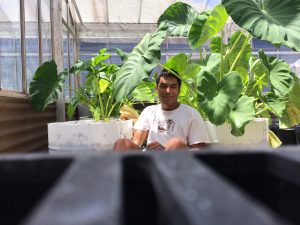Written by Leslie Hutchins
Summer 2018
Agricultural research and production is commonly grounded in one scientific knowledge base, the Western. However, there are other valid forms of knowledge in the world offering salient techniques and perspectives. Indigenous science (IS), the transmission of ecological knowledge in Indigenous communities across generations, is example of another form of knowledge that should be honored and looked to for answers for present day agricultural issues.
Through the support of the Food Systems Scholarship program this summer, I was able to get into the nitty gritty of how IS can offer said guidance. Working with the Indigenous Cropping Systems lab at the University of Hawai’i at Mānoa, I conducted research to shed light on how Hawaiians maintained nitrogen, an essential element needed for plant growth, in their large-scale dryland agroforestry systems in Kona. The Indigenous Cropping System lab conducts agricultural research across the Hawaiian Islands with a focus on understanding the mechanisms underpinning traditional Polynesian agroecosystems and subsequently revitalizing them. My research this summer built on previous work my mentor Dr. Noa Lincoln and I have been doing since 2015, which first involved conducting archival and ethnographic work in order to understand what nutrient management practices were taking place in these systems, and then designing projects to test the N-fixation occurring through these practices.
The projects designed include a mulch mixture treatment decomposition study (carried out from 2015-2017) and a taro grown in mulch study (currently in progress). Specifically, I spent this summer doing data analysis for the mulch decomposition study; conducting semi-formal interviews with taro farmers; and collecting data for the taro grown in mulch study. The mulch decomposition study was comprised of collecting leaf litter from crops traditionally found in Hawaiian agroforestry systems (e.g. candlenut, breadfruit, and sugarcane); drying the litter and bagging it in different ratios (treatments) in mesh bags; setting the mesh bags in a sweet potato field to decompose for a year; and collecting a portion of the mesh bags every month to conduct an acetylene reduction assay, a method used to estimate nitrogen fixation (N-fixation).
Preliminary results from the decomposition study show that there is a significant difference between the amount of N-fixation that occurs between mulch treatments. Specifically, mulch mixtures that had a 50:50 ratio of sugarcane to breadfruit had the highest N-fixation rate over time. Conversely, mulch mixtures that had 50:50 or 25:75 candlenut to breadfruit ratios had the lowest overall N-fixation rate over time. Calculating the N-fixation rate (contribution) for each mulch mixture per every 2 pounds of litter and dividing it by the amount nitrogen (N) required for commercial dryland taro growth per acre (~350 pounds), it was found that Hawaiians would have needed at least 11 tons of leaf litter in order to maintain a sufficient supply of N to keep their staple crop fields productive by today’s commercial standards. This is an absurd amount of litter to be acquired, thus it is highly unlikely that Hawaiians solely relied on leaf litter — at least not the litter used in this project — for their N needs. In order to refine and advance our results and test out other crop litter, we initiated the taro grown in mulch project this summer. The project involves growing the same taro variety in four different mulch treatments for 9 months (the growth cycle of taro) while measuring plant traits and N-fixation once a month.
Again, this work would not have been possible without support from Food Systems Scholarship. Thanks to the scholarship I gained a lot in a short amount of time this summer. Firstly, I learned more about my Hawaiian culture and how my ancestors managed their productive and sustainable agro-ecosystems. Secondly, I advanced my data management and analysis skills. Thirdly, I cultivated relationships with Hawaiian farmers and scholars that will hopefully last a lifetime. And finally, I reconnected myself into the food system movement in Hawaiʻi. My experience this summer will allow me to be better prepared to support my lāhui (community). In addition, it has solidified my asipirations to do research grounded in bridging the Indigenous and Western worlds in graduate school.
Funding for this project was partially provided by the American Cultures Engaged Scholarship Program at UC Berkeley.

